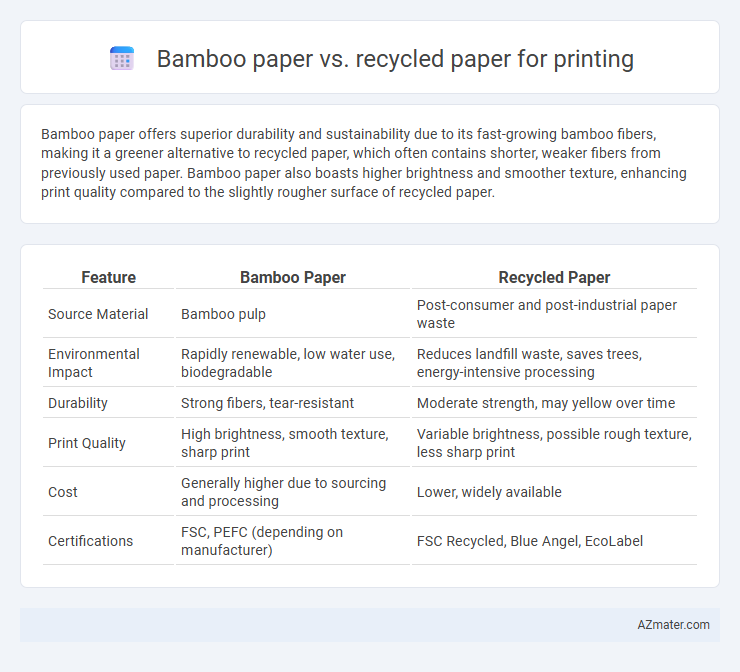Bamboo paper offers superior durability and sustainability due to its fast-growing bamboo fibers, making it a greener alternative to recycled paper, which often contains shorter, weaker fibers from previously used paper. Bamboo paper also boasts higher brightness and smoother texture, enhancing print quality compared to the slightly rougher surface of recycled paper.
Table of Comparison
| Feature | Bamboo Paper | Recycled Paper |
|---|---|---|
| Source Material | Bamboo pulp | Post-consumer and post-industrial paper waste |
| Environmental Impact | Rapidly renewable, low water use, biodegradable | Reduces landfill waste, saves trees, energy-intensive processing |
| Durability | Strong fibers, tear-resistant | Moderate strength, may yellow over time |
| Print Quality | High brightness, smooth texture, sharp print | Variable brightness, possible rough texture, less sharp print |
| Cost | Generally higher due to sourcing and processing | Lower, widely available |
| Certifications | FSC, PEFC (depending on manufacturer) | FSC Recycled, Blue Angel, EcoLabel |
Introduction: The Need for Sustainable Printing Paper
Sustainable printing paper options like bamboo paper and recycled paper address growing environmental concerns related to deforestation and waste management. Bamboo paper offers rapid renewability and natural antimicrobial properties, while recycled paper reduces landfill impact and conserves natural resources by reprocessing used fibers. Choosing between bamboo and recycled paper involves evaluating factors such as carbon footprint, durability, and printing quality to support eco-friendly consumption.
What is Bamboo Paper?
Bamboo paper is made from the pulp of bamboo grass, a fast-growing and sustainable plant known for its strength and renewability. It offers a smooth texture and high durability, making it an eco-friendly alternative to conventional wood-based printing paper. Bamboo paper's natural antibacterial properties and lower water consumption during production add to its environmental benefits compared to recycled paper.
What is Recycled Paper?
Recycled paper is produced from collected waste paper products that are reprocessed and reformed into new sheets, significantly reducing the demand for virgin wood pulp and lowering environmental impact. It typically contains varying percentages of post-consumer fiber, which helps conserve natural resources and decrease landfill waste. Compared to bamboo paper, recycled paper prioritizes sustainability through reuse, although bamboo paper offers advantages like faster renewability and naturally high fiber strength.
Environmental Impact Comparison
Bamboo paper offers a significantly lower environmental footprint compared to recycled paper due to bamboo's rapid growth rate and minimal need for pesticides or fertilizers, enabling faster carbon sequestration and less habitat disruption. Recycled paper reduces deforestation by repurposing existing fibers but often involves intensive chemical processing and energy consumption, which can offset some environmental benefits. Lifecycle assessments reveal bamboo paper typically generates lower greenhouse gas emissions and water usage, making it a more sustainable option for eco-conscious printing needs.
Production Processes: Bamboo vs Recycled Paper
Bamboo paper production involves harvesting fast-growing bamboo stalks, which are mechanically or chemically processed into pulp, resulting in a sustainable and renewable source with minimal environmental impact. Recycled paper production uses post-consumer or post-industrial waste paper, which undergoes de-inking, cleaning, and re-pulping to create new paper sheets, reducing landfill waste and conserving trees. Both methods offer eco-friendly alternatives to virgin wood paper, but bamboo's rapid growth cycle and lower chemical usage provide advantages in carbon footprint and resource efficiency.
Print Quality and Performance Differences
Bamboo paper offers superior print quality with a smoother texture and brighter white surface, resulting in sharper images and more vibrant colors compared to recycled paper. The natural fibers in bamboo paper provide consistent ink absorption and less dust, enhancing printer performance and reducing jams. Recycled paper tends to have a rougher surface and variable fiber composition, which can cause uneven ink distribution and lower overall print clarity.
Cost and Market Availability
Bamboo paper generally costs more than recycled paper due to its sustainable production process and limited manufacturing facilities, while recycled paper offers more competitive pricing because of widespread availability and established recycling systems. Market availability of recycled paper is higher, with extensive supply chains supporting bulk printing needs, whereas bamboo paper remains a niche product primarily found in eco-conscious retailers. Cost-efficiency for large-scale printing often favors recycled paper, but businesses targeting sustainability may invest in bamboo paper despite its premium price and lower availability.
Certifications and Eco-Labels
Bamboo paper often carries certifications such as FSC (Forest Stewardship Council) and PEFC (Programme for the Endorsement of Forest Certification), ensuring sustainable bamboo harvesting practices. Recycled paper typically features certifications like Green Seal and EPA's Recycled Content Certification, which verify the percentage of post-consumer content and environmental impact reduction. Both eco-labels highlight commitment to reducing deforestation and promoting resource conservation in printing paper production.
User Applications and Suitability
Bamboo paper offers superior durability and smooth texture, making it ideal for high-quality printing tasks such as invitations, business cards, and professional documents, where appearance and strength are critical. Recycled paper provides an eco-friendly and cost-effective option suitable for everyday printing needs like internal memos, drafts, and bulk printing, balancing environmental impact with performance. Users seeking a premium, sustainable alternative often prefer bamboo paper, while those prioritizing affordability and environmental conservation typically choose recycled paper.
Which is Better: Bamboo or Recycled Printing Paper?
Bamboo paper offers superior strength, faster renewability, and a lower environmental footprint compared to traditional recycled paper, making it a more sustainable choice for printing needs. Recycled paper reduces waste and conserves resources by repurposing existing fibers but often involves chlorine bleaching and lower durability. For eco-conscious printing, bamboo paper is generally better due to its rapid growth cycle, minimal chemical processing, and higher quality print results.

Infographic: Bamboo paper vs Recycled paper for Printing paper
 azmater.com
azmater.com